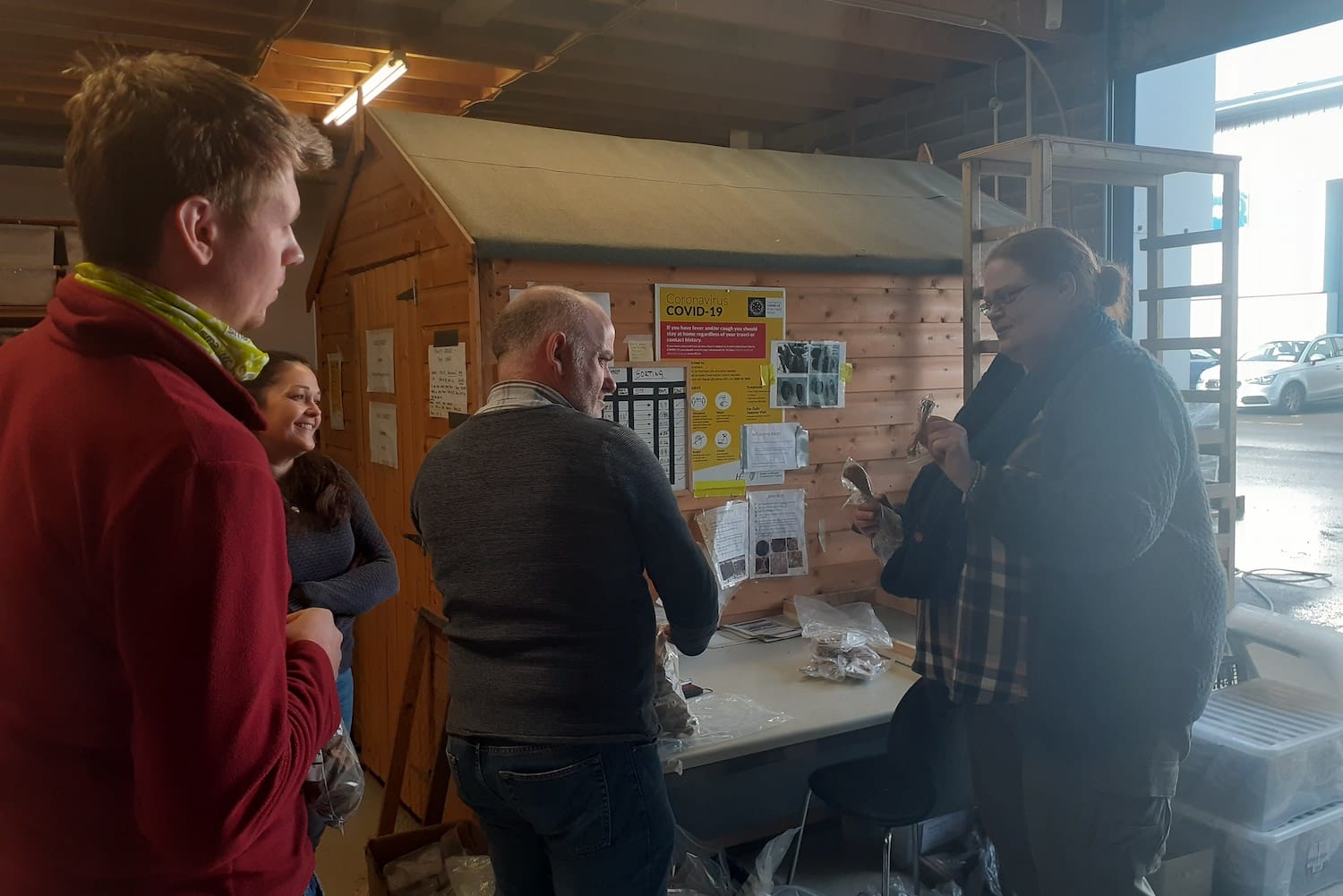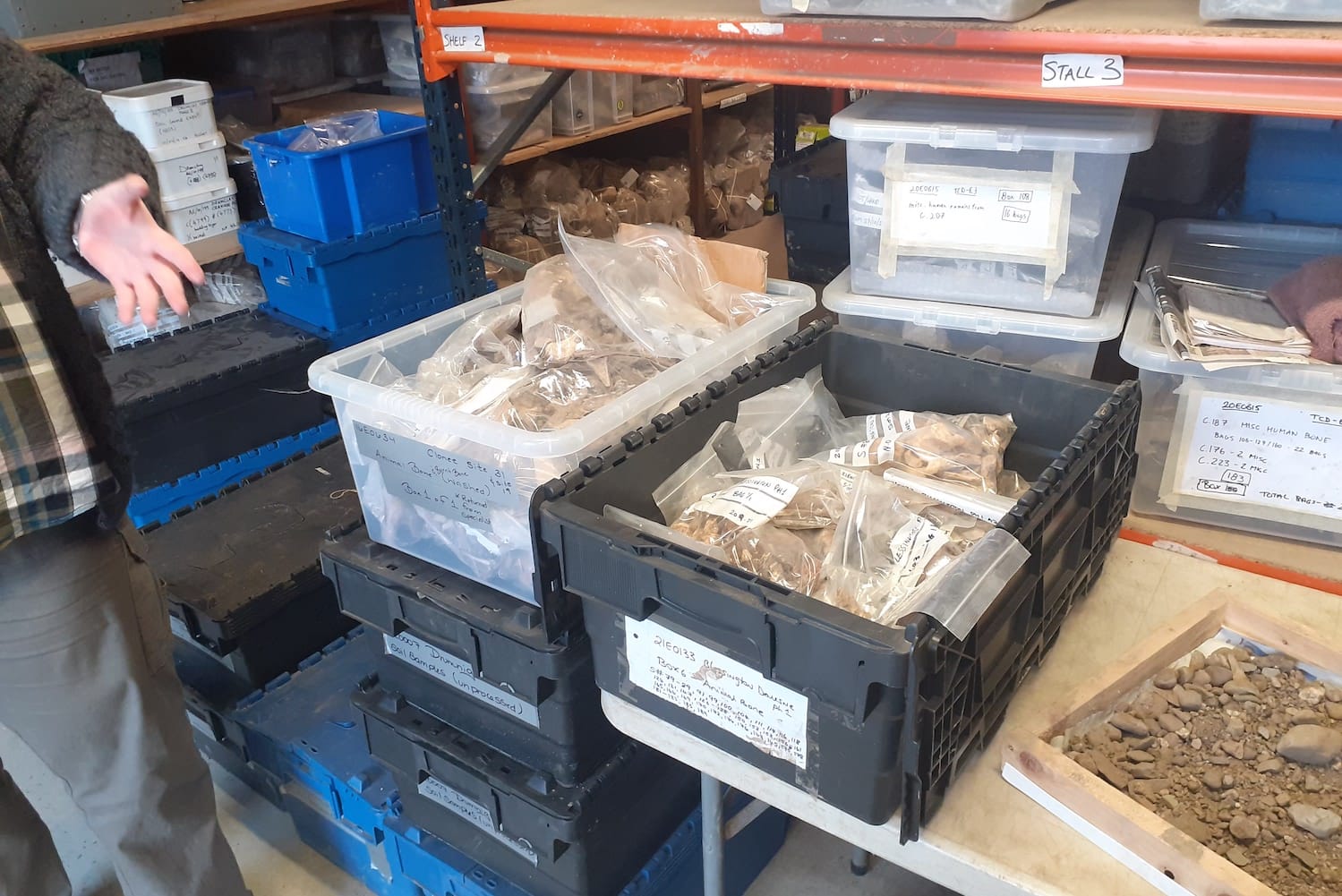Months on, council still investigating ethics complaints against independent councillor
Two councillors have lodged complaints with the council against independent Councillor Gavin Pepper. But there’s been no conclusion yet to those processes.
Learning about Viking dogs is a way to connect with those who lived thousands of years ago, says Ruth Carden. “They seem so far removed.” But they also had pets.

Ruth Carden runs her finger along the jagged teeth of the jaw bone.
The yellow stumps, once sharp enough to tear meat, jut up between holes left by those that fell out sometime between 600 and 1,400 years ago.
“These are the incisor, what’s left of the incisor, and a big canine tooth would be right here,” says Carden, as she points at a gap.
She taps a row of premolars, still preserved. “One, two, three, four.”
From a plastic bag, she pulls out yet more bones and scatters them onto a table in the Kilcoole warehouse of the Irish Archaeological Consultancy.
Carden jigsaws a partial skull next to the jaw. “The jaw would fit here basically and the nose would be down here.”
These bones were excavated in 2017 from the ground underneath where shoppers today buy groceries from Lidl on Aungier Street, says Carden, a zooarchaeologist at the School of Archaeology at University College Dublin.
They are likely from two large dogs that lived during Viking times, she says.
What role these dogs had in society – whether they were eaten as food, run as hunters, or loved as pets – is a question she and others on the Viking Dublin Dogs research team are seeking to answer.
The team plan to analyse hundreds of Viking dog bones from around Ireland and the United Kingdom, as part of a project to learn more, she says. “It’s the history of dogs, and the association of human emotion and dogs.”
Last Wednesday, Carden and three other archeologists stood by a table near the open warehouse door.
Andrew Fairbrother, a site supervisor for the Irish Archaeological Consultancy, pulled a short browning bone from a labelled plastic bag and handed it to her.
Carden took a quick look. It’s a metapodial, she says. “So this would be in a small to medium-size dog.”
It’s likely a paw bone from a dog the size of a springer spaniel, she says. “I’m not saying it’s a springer spaniel!”

From June to November, Fairbrother and site director Muireann Ní Cheallacháin had been excavating a site on the other side of the Wicklow Mountains at Blessington Demesne.
They dug down and logged bags of layers of soil, before hitting a medieval ditch with charcoal, waste and animal bones, says Ní Cheallacháin.
“This was their rubbish pit. When they finished eating, they dumped it in,” she says. “We were finding animals nearly everywhere.”
They found plenty of animal bones on the site, says Ní Cheallacháin. Cow, sheep, goat, horse and fox, she says.
Carden came to rifle through the bones. “From her quick look we have possibly three different dogs,” says Ní Cheallacháin.
To gather dog bones, Carden has reached out to other zooarchaeologists, those who specialise in excavated animal remains, and archeology companies around Ireland and the UK, like the Irish Archaeological Consultancy.
To date, she has 282 dog bones found on a Viking site on Chancery Lane, says Carden, and some found under the Lidl site on Aungier Street.
Those working on Viking sites in Fingal, Cork, Roscommon and Kildare also came through with potential dog bones to take a look at, she says. As did digs in Co. Down, and in York and Ipswich in England.
Archeologists often excavate a site before construction starts on a new development, says Carden. “All these sites now are probably covered in buildings or apartments.”
A few of the older adult dog bones have evidence of healed breaks, says Carden. “It kind of hits home in the heart.”
It means someone cared for that dog, she says. “Fed it, looked after it while it was injured – it probably walked with a limp the rest of its life.”
She wants to know more about these dogs, she says. “Were you big or small? What colour were you? What was your role?”
“Were you there just as a pet, or were you guarding the house, or herding sheep for the person, or hunting with them?” says Carden.
From her collection so far, she knows the dogs varied in size and, potentially, breed. But she needs to do more tests, she says.
DNA tests would show the sex and whether the Vikings bred dogs with wolves, she says. “They’re Vikings, liable to do anything.”
Isotope testing would show what dogs were eating and so what was traded to Ireland at the time, she says.

The team has funding for DNA and isotope tests already, she says.
But they haven’t covered the budget for radiocarbon dating to find out exactly when the dog bones were buried, says Carden.
They could date from 700 to 1400 AD, she says. “That’s a huge range of time.”
It’s harder to analyse the DNA and isotype test results without radiocarbon dating, she says. “Think of the dating as being your spine. Everything else hangs off it”
She plans to launch a fundraiser after Christmas to pay for the 14 Chrono Centre at Queen’s University Belfast to date them, she says, and give people the chance to follow the research.
Ní Cheallacháin says dog owners may want to know more about their dog’s heritage, she says. “Whoever I know who has dogs, they are part of the family.”
Her own dog, Spíoróg, is a springer spaniel. “I just want to know if my dog in Naas is in any way related to the dog in Blessington, because it’s only a couple of hours distance.”
Learning about Viking dogs is also a way to connect with those who lived thousands of years ago, she says. “They seem so far removed.”
But they also had pet dogs, she says. “Did they love them? Did they bury them nicely? What did they mean to them in their life?”
Growing up, Carden had a springer spaniel too, named Ruby. “She was super intelligent. She was brilliant, oh, she’d know what you were thinking,” she says fondly.
The Kilcoole warehouse holds pallets of prehistoric stone, piles of soil bags, and floor-to-ceiling shelves of storage boxes, labelled with log numbers and dates and descriptions such as “miscellaneous human remains”.
Once these bags and boxes are delivered to the Irish Archaeological Consultancy warehouse, there’s work to do to figure out what has been found.
On Wednesday, an archeologist cut through the group, carrying a pile of soil on a gauze frame outside to a flotation tank in the car park. In the tank, organic materials in the dirt float to the top.
“It’s washing dirt off the dirt,” says Ní Cheallacháin, and the others laugh.
Ní Cheallacháin goes into a shed in the warehouse and brings out a gauze frame from the Blessington site.
Filtered soil has to be double-checked for anything that might not have floated. “We literally have to go through it with the tweezers,” she says.
John O’Neill, a research manager, and Fairbrother start prodding their fingers around the crumbs of soil and rocks.
Fairbrother pulls out a prehistoric flint scraper with its edges sharpened. “Hey, look!”
“So that’s about 4,000 years old,” says Ní Cheallacháin, turning it in her palm. “It fits right on your thumb and it was literally for taking skin off or the hides off animals.”
Behind her, another archeologist dips a human bone fragment into a bucket of water, and scrubs it clean with metal bristles. They place it in a neat line next to other human bones.
“It’s doing the dirty work,” says O’Neill, leaning on the shed. Those cleaned and labelled artefacts are sent out to specialists like Carden.
With the specialists’ summaries of the artefacts and radiocarbon dating, the site director then creates a narrative about the site, says Ní Cheallacháin.
“What were they doing there?” she says. “Why was there so much bone? Why was there so much charcoal? Just to come up with a nice story of what was happening here.”
The bigger picture makes the hard work digging on a site, sometimes working in the rain or wind, all worthwhile, says Fairbrother.
“If you find a dog, you can imagine someone walking around their early medieval ring fort with a dog,” he says. You can make that connection with your own life, Fairbrother says.